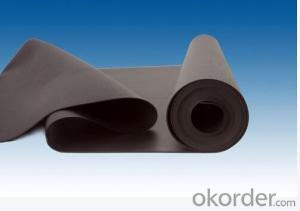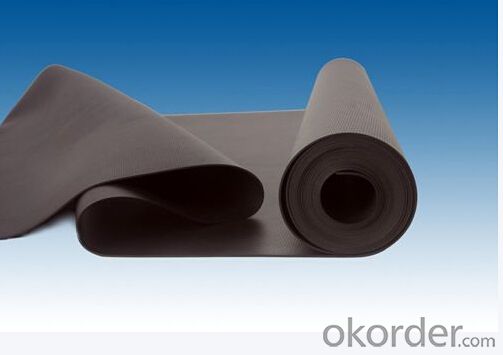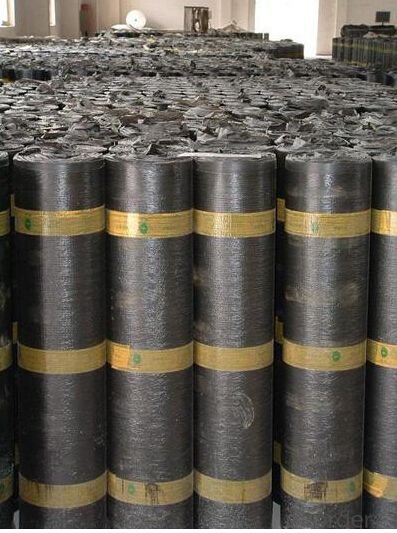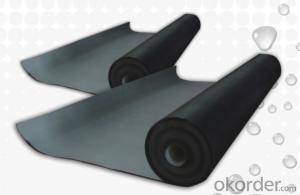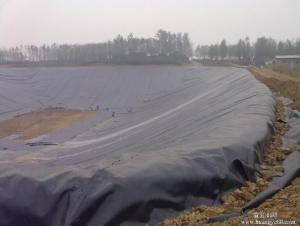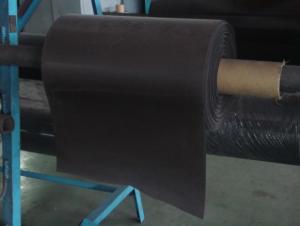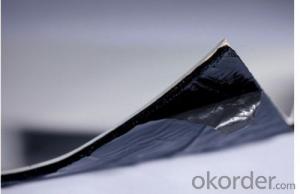EPDM Waterproofing Membrane for Roof Construction
- Loading Port:
- China Main Port
- Payment Terms:
- TT OR LC
- Min Order Qty:
- -
- Supply Capability:
- -
OKorder Service Pledge
OKorder Financial Service
You Might Also Like
EPDM waterproofing Rubber membrane
1. Product Description:
EPDM waterproofing membrane is made from ternary ethylene-propylene rubber. We adopts the world advanced equipment of cold feeding
extrusion and continuous vulcanization technology. With the best performance among high polymer waterproof materials,
EPDM is of exceptional elasticity and will not split or crack under normal building movement.
2. Product Specification:
Type | epdm waterproofing membrane |
Material | EPDM Rubber |
Surface | Fleece back,plain black back |
Thickness | 1.2mm,1.5mm,2.0mm |
Width | 1.2m, 2m-4m, customized |
Length | 20m/roll |
Usage | basements, ponds, Lake, steel structure roofing, underground, tunnels |
Weight(kg/roll) | 1.2mm 37-38 |
1.5mm 40-41 | |
2.0mm 58-59 |
3. Technical Data:
Tensile Strength N/CM | Normal temperature: ≥60 ; 60°C: ≥30 |
Breaking Elongation % | Normal temperature: ≥400; -20°C: ≥10 |
Tear Resistance N | ≥20 |
Impermeability, 30 min no leakage | 0.3Mpa |
Low Temperature Bending °C | ≤ -20 |
Heating Shrinking mm | Extension: ≥2; Shrink: ≥4 |
Heat Resistance (80°C×168h) | Tensile Strength %: ≥80 ; Keeping rate of adhesive breaking:≥70 |
Synthetic aging | Tensile Strength %: ≥80 ; Keeping rate of adhesive breaking:≥80 |
4. Product Application:
Widely used in roofs, basement, toilet, swimming pool, and all kinds of industry and civil building waterproofing, reservoir, vivicism, bridge, underground, tunnel and dam waterproofing, especially to the keystone waterproofing projects which is durability, high corrosion resistance and easy deformation.
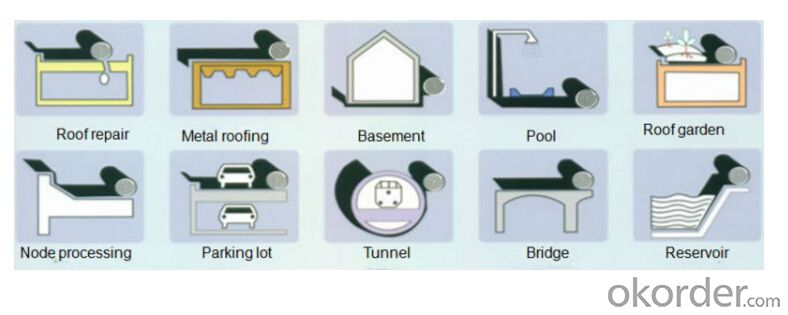
4. Some photos:
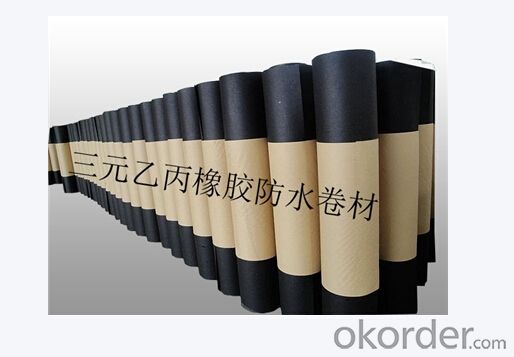

- Q: Can a waterproofing membrane be used on precast concrete surfaces?
- Yes, a waterproofing membrane can be used on precast concrete surfaces. It helps to prevent water penetration and protect the concrete from moisture damage.
- Q: How thick should a waterproofing membrane be applied?
- The application of a waterproofing membrane is dependent on several factors, including the type of membrane, its intended use, and the project's specific requirements. Typically, the thickness of a waterproofing membrane can vary between 1 and 2 millimeters. When using liquid-applied membranes, it is advisable to apply multiple coats in order to achieve the desired thickness. The number of coats and the thickness per coat will be determined by the manufacturer's instructions and the specific needs of the application. For sheet membranes, the thickness is generally predetermined by the manufacturer and is available in various options, ranging from 0.5 to 2 millimeters. The selection of the appropriate thickness should be based on the project's specific needs, taking into account factors such as the condition of the substrate, expected movement, and required level of protection. In certain instances, local building codes and regulations may also dictate the thickness of the waterproofing membrane. To determine the suitable thickness for a particular application, it is important to consult with a professional waterproofing contractor or refer to the guidelines provided by the manufacturer.
- Q: Does a waterproofing membrane require any special considerations for installation in seismic zones?
- Yes, a waterproofing membrane does require special considerations for installation in seismic zones. Seismic zones are prone to earthquakes and ground movements, which can cause significant stress and strain on the building structure. When installing a waterproofing membrane in such areas, it is crucial to ensure that it can withstand the potential movements and vibrations caused by seismic activities. Some of the special considerations for installing a waterproofing membrane in seismic zones include: 1. Flexibility: The membrane should have sufficient flexibility to accommodate the movement of the building structure during an earthquake. It should be able to stretch, contract, and withstand dynamic forces without tearing or losing its waterproofing properties. 2. Compatibility: The waterproofing membrane should be compatible with the building materials and systems used in seismic zones. It is important to select a membrane that can bond well with the substrate and other construction components to create a seamless and robust waterproofing system. 3. Reinforcement: In high seismic areas, it is recommended to reinforce the waterproofing membrane with additional layers or reinforcements. This can be done by adding a fabric or mesh layer to enhance the membrane's tensile strength and resistance to tearing caused by seismic movements. 4. Proper installation techniques: The installation of the waterproofing membrane in seismic zones should follow specific guidelines and techniques to ensure its effectiveness. It may involve using specific adhesives, primers, or mechanical fastening systems to secure the membrane properly. 5. Quality control: Regular inspections and quality control measures should be implemented during and after the installation process. This helps to identify any potential issues or deficiencies in the waterproofing system, allowing for prompt repairs or adjustments to be made. By addressing these special considerations, the installation of a waterproofing membrane in seismic zones can help protect the building structure from water intrusion and potential damage caused by earthquakes. Consulting with experienced professionals and following industry standards and guidelines is crucial to ensure a successful installation in these challenging environments.
- Q: Can a waterproofing membrane be applied on top of existing waterproofing systems?
- Yes, a waterproofing membrane can be applied on top of existing waterproofing systems. This additional layer can provide extra protection and reinforce the existing waterproofing system, ensuring better resistance against water infiltration and extending the lifespan of the waterproofing.
- Q: Can a waterproofing membrane be used on concrete walls?
- Concrete walls can benefit from the use of a waterproofing membrane. These membranes are specifically designed to prevent water from penetrating the surface and can be applied to various surfaces, including concrete walls. Common materials used for these membranes include modified bitumen, rubberized asphalt, and synthetic polymers, all of which are highly resistant to water and moisture. By applying a waterproofing membrane to concrete walls, one can effectively prevent water seepage, dampness, and potential damage caused by water infiltration. The membrane acts as a protective barrier, stopping water from permeating through the concrete and reaching the interior spaces. Additionally, it helps maintain the structural integrity of the concrete by reducing the risks of cracks, efflorescence, and other forms of moisture-related deterioration. There are several types of waterproofing membranes available in the market, such as sheet membranes, liquid membranes, and cementitious coatings. The choice of the membrane depends on factors such as the specific application, the degree of water exposure, and the condition of the concrete wall. It is essential to select a membrane that is compatible with the concrete and provides long-lasting waterproofing protection. Before applying the membrane, it is crucial to properly prepare the concrete surface. This involves tasks such as cleaning, repairing any cracks or imperfections, and ensuring that the surface is dry and free from contaminants. The membrane is then installed according to the manufacturer's instructions, which usually involves adhering it to the concrete or applying a liquid membrane with a brush or roller. To sum up, a waterproofing membrane is a valuable solution for protecting concrete walls from water infiltration. By choosing the right type of membrane and following proper installation procedures, one can effectively preserve the durability and longevity of the concrete while safeguarding the interior spaces from potential water damage.
- Q: Can a waterproofing membrane be used for plaza decks?
- Plaza decks necessitate safeguarding against water infiltration to avoid harm to the underlying structure. This is where the application of a waterproofing membrane comes into play. These membranes are specifically designed to create a barrier, preventing water from permeating the deck and causing issues like leaks, deterioration, and structural damage. Typically composed of materials such as bitumen, rubber, or polyurethane, these membranes boast high resistance against water penetration. By incorporating a waterproofing membrane onto a plaza deck, it ensures the deck remains impervious to water, thereby preserving the integrity of the entire structure. Furthermore, these membranes offer additional advantages such as UV resistance, durability, and easy maintenance, rendering them an ideal solution for plaza decks.
- Q: Can a waterproofing membrane be installed on a sloping surface?
- Yes, a waterproofing membrane can be installed on a sloping surface. In fact, it is often necessary to install a waterproofing membrane on sloping surfaces to ensure proper drainage and prevent water accumulation. The installation process may vary depending on the type of waterproofing membrane being used, but typically involves preparing the surface, applying a primer or adhesive, and then carefully placing and securing the membrane. It is important to ensure that the membrane is properly installed and sealed to effectively protect against water infiltration, especially on a sloping surface where water can easily flow and pool.
- Q: Can a waterproofing membrane be used for bridge abutments?
- Yes, a waterproofing membrane can be used for bridge abutments. Waterproofing membranes are commonly used in construction to prevent water infiltration and protect structures from moisture damage. Bridge abutments, which are the supports at either end of a bridge, are particularly vulnerable to water damage due to their proximity to water bodies and potential exposure to groundwater. Applying a waterproofing membrane to bridge abutments can help to create a barrier against water penetration, preventing potential damage to the structure. The membrane is typically installed on the abutment walls and extends below the ground level to ensure complete protection. Waterproofing membranes are designed to be durable and flexible, allowing them to withstand the movement and settling that can occur in bridge abutments. They are often made from materials such as bitumen, PVC, or modified bitumen, which provide excellent resistance to water and other environmental factors. By using a waterproofing membrane on bridge abutments, engineers and contractors can ensure the longevity and safety of the structure. It helps to prevent moisture-related issues such as concrete deterioration, corrosion of reinforcing steel, and the development of cracks and leaks. Additionally, the membrane can also act as a vapor barrier, reducing the potential for condensation and moisture buildup within the abutments. In conclusion, waterproofing membranes are an effective solution for protecting bridge abutments from water damage. They provide a reliable barrier against water penetration, ensuring the structural integrity and durability of the bridge.
- Q: Can a waterproofing membrane be used on concrete block surfaces?
- Yes, a waterproofing membrane can be used on concrete block surfaces. Waterproofing membranes are designed to provide a barrier against moisture and water penetration, and they are commonly used on concrete block surfaces to protect against water damage and leaks. These membranes are typically applied as a liquid or sheet material and adhere to the surface of the concrete blocks, creating a protective layer that prevents water from seeping through. The waterproofing membrane helps to extend the lifespan of the concrete blocks by reducing the risk of water damage, mold growth, and deterioration. It is important to choose a waterproofing membrane that is specifically designed for concrete block surfaces and follow the manufacturer's instructions for proper installation to ensure the best results.
- Q: Does a waterproofing membrane require any protective coatings or sealants?
- In order to enhance its performance and durability, a waterproofing membrane typically needs some form of protective coatings or sealants. While the membrane itself provides waterproofing to some extent, it may not be enough to withstand all environmental conditions or potential damage. To create an extra barrier against water intrusion, UV radiation, mechanical stress, and chemical exposure, it is advisable to apply protective coatings or sealants on top of the membrane. These coatings or sealants also offer additional flexibility, strength, and protection against wear and tear. To determine the suitable type of coating or sealant for the specific membrane and project requirements, it is essential to seek advice from a professional waterproofing specialist.
Send your message to us
EPDM Waterproofing Membrane for Roof Construction
- Loading Port:
- China Main Port
- Payment Terms:
- TT OR LC
- Min Order Qty:
- -
- Supply Capability:
- -
OKorder Service Pledge
OKorder Financial Service
Similar products
Hot products
Hot Searches
Related keywords
